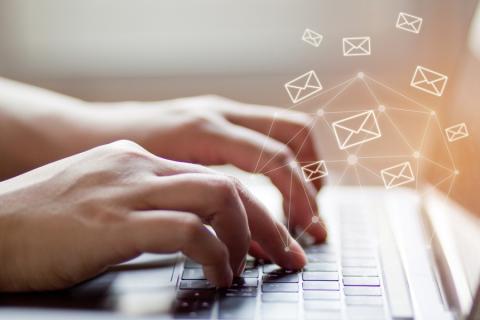
How to write a greeting email to a client in Hong Kong
Estimated Read Time: 3 minutes
Ask ten Hong Kong professionals what the best first email greeting should be and you will probably receive ten different answers.
For some, you must remain formal at all times, and onl Dear and Sincerely will do.
For others, a simple Hey, Cheers or even Thnx are perfectly appropriate.
Many of us send off so many emails in a day that it’s easy to consider them casual. Some certainly are — for example, sending a quick note to ask a co-worker a question or putting in your lunch order for the meeting next week. In those cases, anything other than a friendly, familiar greeting would come off as ... well, weird.
But not every email is as informal, of course, and taking a relaxed attitude with each message is a big mistake. You want to be more professional when emailing someone you've worked with only a few times before, a new client or a company executive, for instance.
Related: Understanding how to prepare for a new job in Hong Kong
Writing a first email greeting
“Treat it like a business letter,” international business etiquette expert Jacqueline Whitmore says of first-time work emails. When in doubt? “It’s better to be more formal than too casual,” she advises.
By being respectful in your email communications, you show the recipient that you are a competent, conscientious businessperson.
This is especially important if you've yet to establish much of a connection with the person you're emailing.
Your email — and your email greeting, in particular — is the first impression he or she has of you. If your email greeting is too informal or personal, it can be off-putting and not give a great first impression; rather that you're rushed, inattentive or sloppy.
Here are several standard approaches to a first email greeting:
- Dear Name — The best bet for business communication.
- Hello, Name — Also acceptable but a little more relaxed
- Hi, Name — The friendliest option while still appearing professional.
- No greeting — Not recommended. Use at your own peril.
“You can hardly be wrong going too formal. But you can be dead wrong going too casual,” Whitmore says. “In the beginning, it’s better to be more formal than casual. As time goes on, and you have a relationship with a person, you can relax a bit.”
Related: How to write a thank you email after completing a job interview
How to sign off an email
Whitmore’s go-to business email closing is Best regards or All my best followed by her name.
But email etiquette is not black-and-white, she says. The email greeting and email sign-off choices she uses “depend who I’m sending the email to, how well I know them and my relationship with them,” she says.
The No. 1 rule, according to her, is to not be too affectionate in your email sign-off.
For someone Whitmore has an established relationship with, “the most affectionate I might get is Warm regards or Kind regards,” she says.
For more casual email communications, you could sign off with a Cheers, Thanks, or Best.
But Whitmore strongly advises steering clear of any text-like abbreviations when it comes to your email sign-off, like Tx or Thank u, no matter whom you're communicating with or how well you know them.
Greeting email to a client - sample
Subject: Warm Greetings and Introduction from [Your Company]
Dear [Client's Name],
I hope this message finds you well.
My name is [Your Name], and I am delighted to extend a warm greeting as a representative from [Your Company]. I wanted to take this opportunity to introduce myself and express our appreciation for the opportunity to work with you.
At [Your Company], we are dedicated to providing exceptional [mention your services/products/solutions] and fostering strong, long-term relationships with our valued clients. We understand the importance of [specific client needs or industry-related challenges], and we are committed to delivering tailored solutions that meet and exceed your expectations.
I am eager to learn more about your current objectives and how we might assist in achieving your goals. Our team is here to provide support, guidance, and innovative solutions that can drive your success.
Should you have any questions, need further information, or would like to schedule a call or meeting, please feel free to reach out. Your satisfaction and success are our priorities, and we look forward to the opportunity to be of service to you.
Thank you for considering [Your Company]. We are excited about the prospect of collaborating with you and contributing to your business growth.
Warm regards,
[Your Name]
[Your Position]
[Your Contact Information]
[Company Name]
Recruiter tips
Hanson Chan is the Senior Division Director for finance and accounting at Robert Half Hong Kong, and brings over 9 years of experience in recruiting for the financial services industry. Leading a team in Actuarial, Finance & Accounting, and Internal Audit, he plays a key role in engaging with clients.
Hanson shares his top tips on how to write your first email greeting to a client:
- Address the recipient by their name, such as 'Dear [Name],' as it is a professional and respectful way to start a greeting email. Ensure you spell their name correctly.
- Strike a balance between professionalism and friendliness in your greeting. This comes across in your tone, which is harder to convey over email than it is on the phone, so aim to use language that is polite and respectful while still showing human emotion.
- Keep your greeting concise and to the point. Avoid lengthy introductions and get straight to the purpose of your email.
- When writing a greeting email, tailor it to consider the recipient's position and the level of formality required.
- Personalise your greeting when possible. If you have a previous connection or shared experience with the recipient, mention it briefly to establish rapport.
- Proofread your greeting email for any spelling or grammatical errors.


